Hotpoint Ariston AQD1070D 69 User Manual [es, it, en]

Instructions for installation and use
WASHER-DRYER
|
|
|
|
! |
This symbol reminds you to read this instruction manual. |
|
|
EN |
|||
|
|
||
|
|
|
|
|
|
|
|
|
Contents |
EN |
|
IT |
|
ES |
|
|
|
|
|
|
|||
|
|
|
|
|
|
|
English,1 |
Italiano,13 |
Español,25 |
Installation, 2-3 |
|||
|
|
|
|
|
|
Unpacking and levelling |
|
|
|
|
|
|
Connecting the electricity and water supplies |
|
|
|
|
|
|
Technical data |
PT |
|
NL |
|
|
|
|
|
|
|
|
Care and maintenance, 4 |
||
|
|
|
|
|
|
|
Português,37 |
Nederlands,49 |
|
|
|||
|
|
Cutting off the water and electricity supplies |
||||
|
|
|
|
|
|
Cleaning the machine |
|
|
|
|
|
|
Cleaning the detergent dispenser drawer |
|
|
|
|
|
|
Caring for your appliance drum |
Cleaning the pump
Checking the water inlet hose
AQUALTIS
AQD1070D 69
Precautions and advice, 5
General safety
Disposal
Opening the porthole door manually
Description of the machine, 6-7
Touch control panel
How to run a wash cycle or a drying cycle, 8
Wash cycles and options, 9
Table of wash cycles
Wash options
Detergents and laundry, 10
Detergent
Preparing the laundry
Washing recommendations
Load balancing system
Trouble shooting, 11
Assistance, 12
1
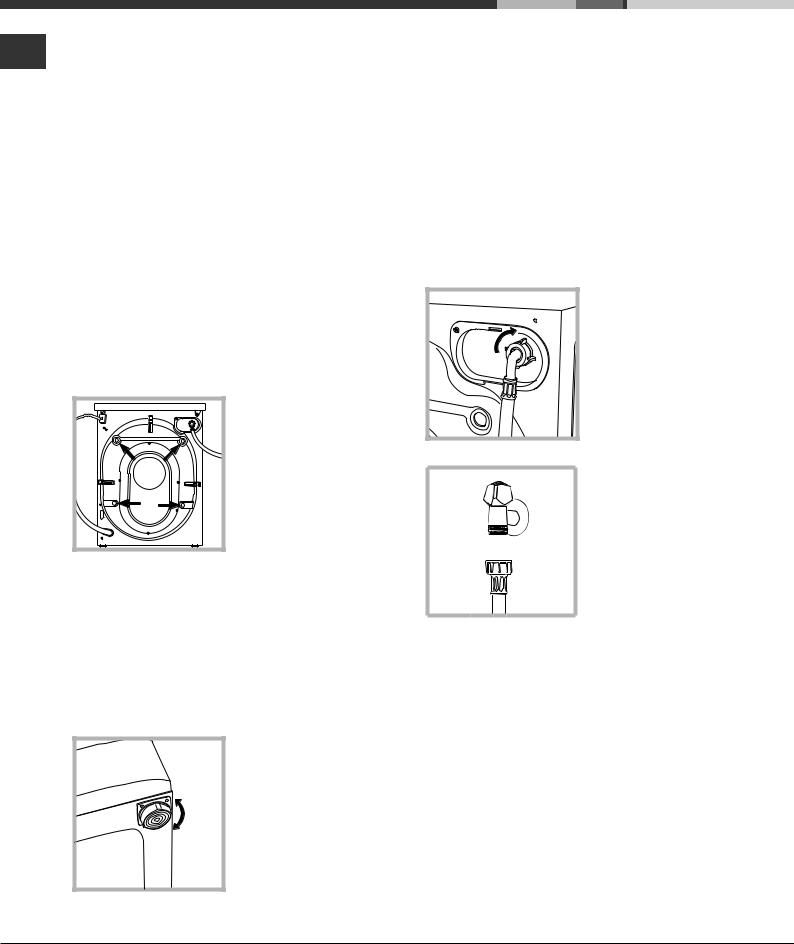
Installation
EN |
! This instruction manual should be kept in a |
|
safe place for future reference. If the Washer- |
||
|
||
|
dryer is sold, given away or moved, please |
|
|
ensure the manual is kept with the machine, |
|
|
so that the new owner may benefit from the |
|
|
advice contained within it. |
|
|
! Read these instructions carefully: they |
|
|
contain vital information relating to the safe |
|
|
installation and operation of the appliance. |
|
|
! Inside the pack containing this manual, you |
|
|
will also find the guarantee and all the details |
|
|
necessary for installation. |
|
|
Unpacking and levelling |
|
|
Unpacking |
|
|
1. Once you have removed all the packaging |
|
|
from the Washer-dryer, make sure it has not |
|
|
been damaged during transportation. |
|
|
If it has been damaged, contact the retailer |
|
|
and do not proceed any further with the |
|
|
installation process. |
|
|
2. Remove the 4 |
|
|
protective screws |
|
|
(used during |
|
|
transportation) and |
|
|
the corresponding |
|
|
spacer, located on |
|
|
the rear part of the |
|
|
appliance (see figure). |
3.Close off the holes using the plastic plugs supplied in the pack.
4.Keep all the parts in a safe place; they will be needed again if the Washer-dryer is moved to another location, to prevent the inside of the appliance being damaged.
! Packaging materials should not be used as toys for children.
Levelling
1. Place the Washerdryer on a flat sturdy floor, without resting it up against walls or
cabinets.
2. If the floor is uneven, the front feet of the machine may be adjusted until it reaches a horizontal position (the angle of
inclination must not exceed 2 degrees).
!If the appliance is levelled correctly, it will be more stable and much less likely to cause vibrations and noise while it is operating, particularly during the spin cycle.
!If it is placed on carpet or a rug, adjust the feet in such a way as to allow a sufficient ventilation space underneath the Washer-dryer.
Connecting the electricity and water supplies
Connecting the water inlet hose
! Before connecting the inlet hose to the water supply, run the water until it is perfectly clear.
1. Connect the inlet hose to the machine by screwing it onto the cold water inlet of the appliance, which is situated on the top right-hand side of the rear part of the appliance (see figure).
2. Connect the inlet hose by screwing it to a cold water tap using a 3/4 gas threaded connection (see figure).
3. Make sure that the hose is not folded over or bent.
! The water pressure at the tap must fall within the values indicated in the Technical data table
(see next page).
!If the inlet hose is not long enough, contact a specialised shop or an authorised technician.
!Never use second-hand or old inlet hoses; use the products supplied with the machine.
2
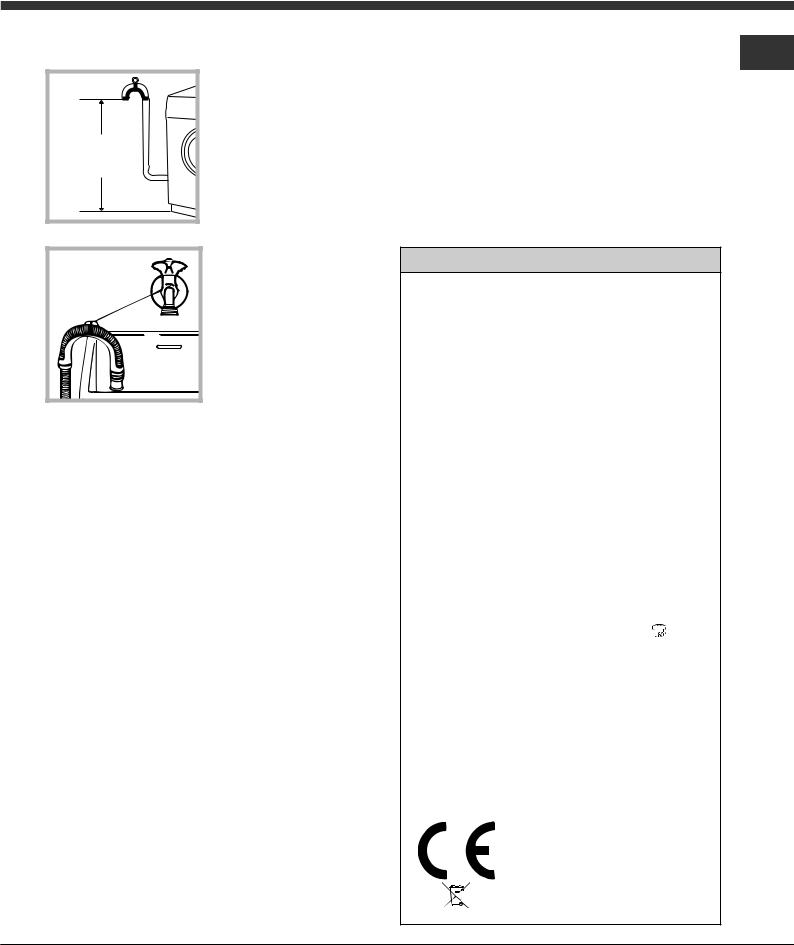
Connecting the drain hose
65 - 100 cm |
Connect the drain hose to drain duct piping or a wall drain located between 65 and 100 cm above the floor, making sure it is not bent at all.
Alternatively, rest the drain hose on the side of a washbasin or bathtub, fastening the duct supplied to the tap (see figure).
The free end of the hose should not be underwater.
! We advise against the use of hose extensions; if it is absolutely necessary, the extension must have the same diameter as the original hose and must not exceed 150 cm in length.
Electrical connections
Before plugging the appliance into the electricity socket, make sure that:
•the socket is earthed and complies with all applicable laws;
•the socket is able to withstand the maximum power load of the appliance as indicated in the Technical data table (see opposite);
•the power supply voltage falls within the values indicated in the Technical data table
(see opposite);
•the socket is compatible with the plug of the appliance. If this is not the case, have the socket or the plug replaced.
!The machine must not be installed outdoors, even in covered areas. It is extremely dangerous to leave the appliance exposed to rain, storms and other weather conditions.
!The mains socket must remain within easy reach after the Washer-dryer has been installed.
! Do not use extension cords or multiple sockets. EN
!The cable should not be bent or compressed.
!The power supply cable and plug must only be replaced by authorised technicians.
Warning! The company shall not be held responsible in the event that these regulations are not respected.
Technical data
Model |
AQD1070D 69 |
|||
|
|
|
|
|
|
|
|
width 59.5 cm |
|
Dimensions |
height 85 cm |
|||
|
|
|
depth 64.5 cm |
|
|
|
|
from 1 to 10 kg for the wash |
|
Capacity |
programme |
|||
from 1 to 7 kg for the drying |
||||
|
|
|
||
|
|
|
programme |
|
Electrical |
please refer to the technical |
|||
data plate fixed to the ma- |
||||
connections |
||||
chine |
||||
|
|
|
maximum pressure |
|
Water con- |
1 MPa (10 bar) |
|||
minimum pressure |
||||
nections |
0.05 MPa (0.5 bar) |
|||
|
|
|
drum capacity 71 litres |
|
Spin speed |
up to 1600 rotations per |
|||
minute |
||||
|
|
|
Wash: programme ; tem- |
|
|
|
|
perature 60°C; using a load |
|
|
|
|
of 10 kg. |
|
Energy ra- |
Drying: the smaller load |
|||
ted |
must be dried by selecting |
|||
programmes |
the “EXTRA” dryness level. |
|||
according to |
The load must consist of 3 |
|||
regulation |
sheets, 2 pillowcases and |
|||
EN 50229 |
1 hand towel; |
|||
|
|
|
the remainder of the load |
|
|
|
|
must be dried by selecting |
|
|
|
|
the “EXTRA” dryness level. |
|
|
|
|
This appliance conforms to |
|
|
|
|
the following EC Directives: |
|
|
|
|
- 2004/108/EC (Electroma- |
|
|
|
|
gnetic Compatibility) |
|
|
|
|
- 2006/95/EC (Low Voltage) |
|
|
|
|
- 2002/96/EC |
|
|
|
|
||
3

Care and maintenance
|
Cutting off the water and |
|
EN |
||
electricity supplies |
||
|
• Turn off the water tap after every wash cycle. |
|
|
This will limit wear on the hydraulic system in |
|
|
the machine and help to prevent leaks. |
|
|
• Unplug the appliance when cleaning it and |
|
|
during all maintenance work. |
Cleaning the machine
The outer parts and rubber components of the appliance can be cleaned using a soft cloth soaked in lukewarm soapy water. Do not use solvents or abrasives.
Cleaning the detergent dispenser drawer
1 |
1 |
2 |
2 |
To remove the drawer, press lever (1) and pull the drawer outwards (2)
(see figure).
Wash it under running water; this procedure should be repeated frequently.
Caring for your appliance drum
•Always leave the door ajar to prevent unpleasant odours from forming.
Cleaning the pump
The Washer-dryer is fitted with a selfcleaning pump which does not require any maintenance. Sometimes, small items (such as coins or buttons) may fall into the protective pre-chamber at the base of the pump.
! Make sure the wash cycle has finished and unplug the appliance.
To access the pre-chamber:
1. take off the cover panel on the front of the machine by first pressing it in the centre and then pushing downwards on both sides until you can remove it (see figures);
2. position a container so that it will collect the water which flows out (approximately 1.5 l)
(see figure);
3. unscrew the lid by rotating it in an anticlockwise direction (see figure);
4.clean the inside thoroughly;
5.screw the lid back on;
6.reposition the panel, making sure the hooks are securely in place before you push it onto the appliance.
Checking the water inlet hose
Check the inlet hose at least once a year. If there are any cracks, it should be replaced immediately: during the wash cycles, water pressure is very strong and a cracked hose could easily split open.
4
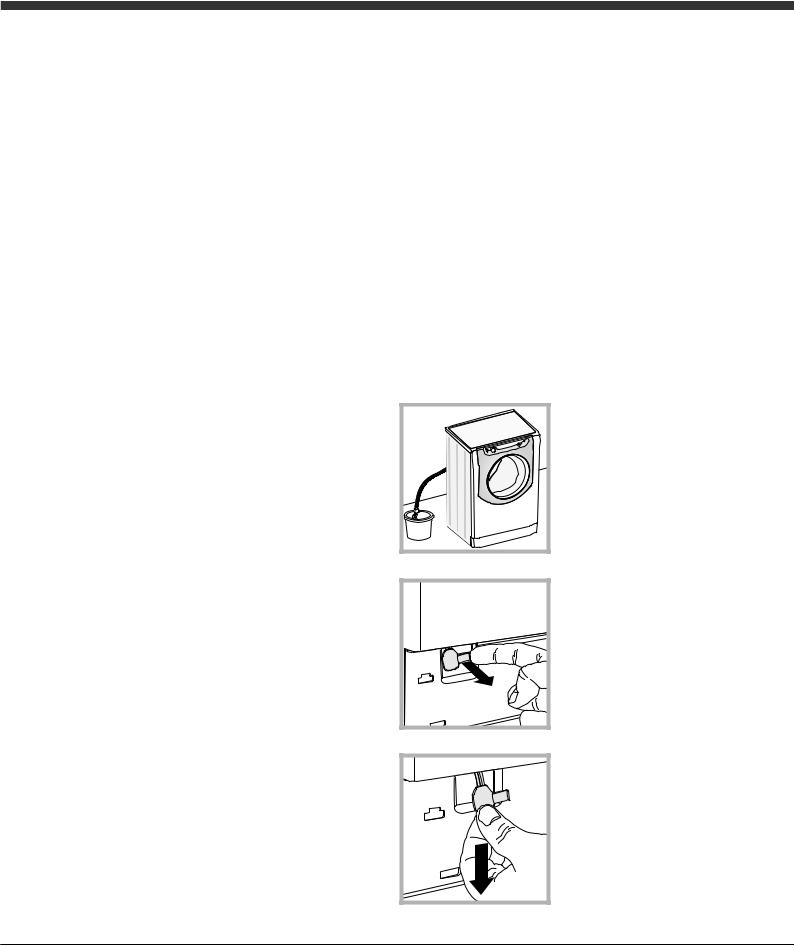
Precautions and tips
! The machine was designed and constructed in accordance with international safety regulations. The following information is provided for safety reasons and must therefore be read carefully.
General safety
•This appliance is not intended for use by persons (including children) with reduced physical, sensory or mental capabilities, or lack of experience and
knowledge, unless they have been given supervision or instruction concerning use of the appliance by a person responsible for their safety.
Children should be supervised to ensure that they do not play with the appliance.
–Do not dry unwashed items in the tumble dryer.
–Items that have been soiled with substances such
as cooking oil, acetone, alcohol, petrol, kerosene, spot removers, turpentine, waxes and wax removers should be washed in hot water with an extra amount of detergent before being dried in the tumble dryer.
–Items such as foam rubber (latex foam), shower caps, waterproof textiles, rubber backed articles and clothes or pillows fitted with foam rubber pads should not be dried in the tumble dryer.
–Fabric softeners, or similar products, should be used as specified by the fabric softener instructions.
–The final part of a tumble dryer cycle occurs without heat (cool down cycle) to ensure that the items are left at a temperature that ensures that the items will not be damaged.
WARNING: Never stop a tumble dryer before the end of the drying cycle unless all items are quickly removed and spread out so that the heat is dissipated.
•This appliance was designed for domestic use only.
•Do not touch the machine when barefoot or with wet or damp hands or feet.
•Do not pull on the power supply cable when unplugging the appliance from the electricity socket. Hold the plug and pull.
•Do not touch the drained water as it may reach extremely high temperatures.
•Never force the porthole door. This could damage the safety lock mechanism designed to prevent accidental opening.
•If the appliance breaks down, do not under any circumstances access the internal mechanisms in an attempt to repair it yourself.
•Always keep children well away from the appliance while it is operating.
•If it must be moved, proceed with the help of two or three people and handle it with the utmost care. Never try to do this alone, because the appliance is very heavy.
•Before loading laundry into the washer dryer, make sure the drum is empty.
•During the drying phase, the door tends to get quite hot.
•Do not use the appliance to dry clothes that have been washed with flammable solvents (e.g. trichlorethylene).
•Do not use the appliance to dry foam rubber or similar elastomers.
• Make sure that the water tap is turned on during |
EN |
|
the drying cycles. |
||
|
||
|
|
Disposal
•Disposing of the packaging materials: observe local regulations so that the packaging may be re-used.
•The European Directive 2002/96/EC relating to Waste Electrical and Electronic Equipment (WEEE) states that household appliances should not be disposed of using the normal solid urban waste cycle. Exhausted appliances should be collected separately in order to
optimise the cost of re-using and recycling the materials inside the machine, while preventing potential damage to the atmosphere and to public health. The crossed-out dustbin is marked on all products to remind the owner of their obligations regarding separated waste collection. For more information relating to the correct disposal of household appliances, owners should contact their local authorities or appliance dealer.
Opening the porthole door manually
In the event that it is not possible to open the porthole door due to a powercut, and if you wish to remove the laundry, proceed as follows:
1. remove the plug from the electrical socket.
2. make sure the water level inside the machine is lower than the door opening; if
it is not, remove excess water using the drain hose, collecting it in a bucket as indicated in the figure.
3. remove the cover panel on the lower front part of the washer dryer (see overleaf). 4. pull outwards using the tab as indicated in the figure, until the plastic tie-rod is freed from its stop position; pull downwards until you hear a “click”, which indicates that the door is now unlocked.
5. open the door; if this is still not possible repeat the procedure.
6. reposition the panel, making sure the hooks are securely in place before you push it onto the appliance.
5
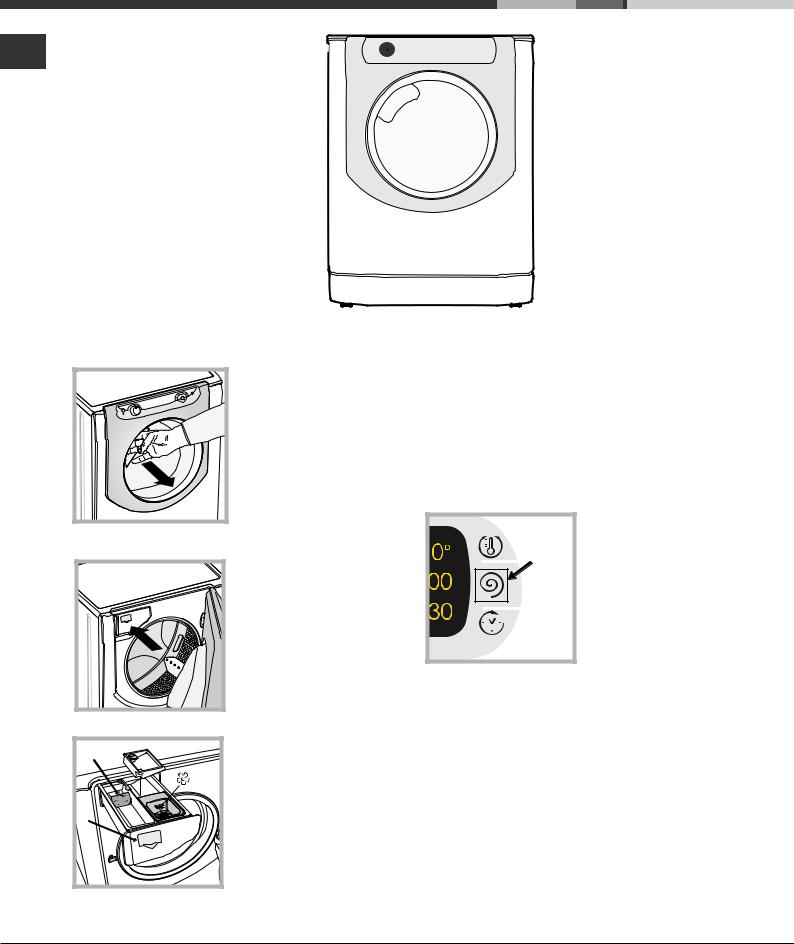
Description of the machine
EN
PORTHOLE DOOR
PORTHOLE DOOR
HANDLE
KICK STRIP
PORTHOLE DOOR
Always use the handle to open the porthole door (see figure).
DETERGENT DISPENSER DRAWER
|
|
|
The detergent dispenser |
|
|
|
drawer is located inside |
|
|
|
the machine and can be |
|
|
|
accessed by opening the |
|
|
|
door. |
|
|
|
For more information on |
|
|
|
detergent measures, please |
|
|
|
refer to the chapter entitled |
|
|
|
“Detergents and laundry”. |
|
A |
|
1. pre-wash compartment: |
|
3 |
use powder detergent. |
|
|
|
! Before pouring in the |
|
|
|
|
|
|
|
1 |
detergent, make sure that |
B |
|
2 |
extra compartment 3 has |
|
been removed. |
||
|
|
|
2. main wash compartment: |
|
|
|
If liquid detergent is used, |
|
|
|
it is recommended that the |
|
|
|
removable plastic partition A |
(supplied) be used for proper dosage.If powder detergent is used, place the partition into slot B.
CONTROL
PANEL
3. extra compartment: Bleach
! The use of extra compartment 3 excludes the prewash function.
 washing additives compartment: for fabric softener or liquid additives. We recommend that the maximum level indicated by the grille is not exceeded, and that concentrated fabric softeners are diluted.
washing additives compartment: for fabric softener or liquid additives. We recommend that the maximum level indicated by the grille is not exceeded, and that concentrated fabric softeners are diluted.
TOUCH CONTROL PANEL
To adjust the settings, gently press the icon inside the sensitive (touch control) area as illustrated in the figure.
Standby mode
This Washer-dryer, in compliance with new energy saving regulations, is fitted with an automatic standby system which is enabled after about 30 minutes if no activity is detected. Press the ON-OFF  button briefly and wait for the machine to start up again.
button briefly and wait for the machine to start up again.
Consumption in off-mode: 0,5 W Consumption in Left-on: 0,5 W
6

|
|
|
|
|
|
|
|
|
|
|
|
|
Touch control panel |
|
|
|
|
START/PAUSE button |
|
||||||
|
|
SPIN |
with indicator light |
WASH |
EN |
|||||||
|
|
|
|
|
|
|
|
|
||||
WASH CYCLE |
|
|
|
M1 |
button |
ECO |
|
CYCLE |
|
|||
SELECTOR knob |
M2 |
TEMPERATURE |
|
|
PHASE |
|
||||||
|
|
|
indicator light |
|
|
|||||||
|
|
|
|
|
button |
|
|
icons |
|
|||
|
|
|
|
|
|
|
|
|
||||
|
|
|
|
|
|
|
|
|
|
|
||
|
|
|
|
|
|
|
|
|
|
|
|
|
|
|
|
|
|
|
|
|
|
|
|
|
|
|
|
|
|
|
|
|
|
|
|
|
|
|
|
|
|
|
|
|
|
|
|
|
|
|
|
|
|
|
|
|
|
|
|
|
|
|
|
|
DISPLAY
|
|
|
|
|
|
|
|
CONTROL PANEL LOCK |
|
|
|
|
|
|
|
|
|
|
|
|
|
|
|
|
|
|
Button with ON/OFF |
|
|
|
OPTION |
|
|
|
|
DRYING |
|
DELAYED START |
button with indicator light |
|||||
|
buttons |
|||||||
indicator light |
|
|||||||
button |
|
|
button |
|
||||
|
|
|
|
|||||
LOCK indicator light
Button with  ON/OFF indicator light: press this briefly to switch the machine on or off. The green indicator light indicates that the machine is switched on. To switch off the Washer-dryer during the wash cycle, press and hold the button for approximately
ON/OFF indicator light: press this briefly to switch the machine on or off. The green indicator light indicates that the machine is switched on. To switch off the Washer-dryer during the wash cycle, press and hold the button for approximately
3 seconds; if the button is pressed briefly or accidentally the machine will not switch off. If the machine is switched off during a wash cycle, this wash cycle will be cancelled.
WASH CYCLE SELECTOR knob: may be turned in either direction. To select the most suitable wash cycle, please refer to the “Table of wash cycles”.
The knob will not move during the wash cycle.
M1-M2 buttons: press and hold one of the buttons to store a cycle with your own set preferences in the memory of the machine. To recall a previously-stored cycle, press the corresponding button.
DRYING button  : press to decrease or exclude drying; the selected drying level or time will appear on the display
: press to decrease or exclude drying; the selected drying level or time will appear on the display
(see “How to run a wash cycle or a drying cycle”).
TEMPERATURE 
 button: press to modify or exclude the temperature setting; the value selected will appear on the
button: press to modify or exclude the temperature setting; the value selected will appear on the
display above (see “How to run a wash cycle or a drying cycle”).
SPIN CYCLE  button: press to modify or exclude the spin cycle; the value selected will appear on the display above (see “How to run a wash cycle or a drying cycle”).
button: press to modify or exclude the spin cycle; the value selected will appear on the display above (see “How to run a wash cycle or a drying cycle”).
DELAYED START  button: press to set a delayed start for the selected wash cycle; the set delay time will appear on the display above (see “How to run a wash cycle or a drying cycle”).
button: press to set a delayed start for the selected wash cycle; the set delay time will appear on the display above (see “How to run a wash cycle or a drying cycle”).
OPTION buttons: press to select the available options. The indicator light corresponding to the selected option will remain lit (see “How to run a wash cycle or a drying cycle”).
WASH CYCLE PHASE icons: these illuminate to indicate the progress of the wash cycle (Wash  – Rinse
– Rinse  – Spin/ Drain – Drying
– Spin/ Drain – Drying  ). The text
). The text
 lights up when the cycle is complete.
lights up when the cycle is complete.
START/PAUSE button with indicator light: when the green indicator light flashes slowly, press the button to start a wash cycle. Once the cycle has begun the indicator light will remain
lit in a fixed manner. To pause the wash cycle, press the button again; the indicator light will flash in an orange colour. If the “LOCK”  indicator light is switched off, the door may be opened. To start the wash cycle from the point at which it was interrupted, press the button again.
indicator light is switched off, the door may be opened. To start the wash cycle from the point at which it was interrupted, press the button again.
LOCK  indicator light: indicates that the porthole door is locked. To open the door, pause the wash cycle (see “How to run a wash cycle or a drying cycle”).
indicator light: indicates that the porthole door is locked. To open the door, pause the wash cycle (see “How to run a wash cycle or a drying cycle”).
CONTROL PANEL LOCK  button with indicator light: to activate or deactivate the control panel lock, press and hold the button for approximately 2 seconds. when the indicator light is illuminated, the control panel is locked (apart from the ON/OFF button). This means it is possible to prevent wash cycles from being modified accidentally, especially where there are children in the home.
button with indicator light: to activate or deactivate the control panel lock, press and hold the button for approximately 2 seconds. when the indicator light is illuminated, the control panel is locked (apart from the ON/OFF button). This means it is possible to prevent wash cycles from being modified accidentally, especially where there are children in the home.
ECO indicator light: the
 icon lights up when, after altering the washing parameters, an energy saving of at least 10% is made. Furthermore, before the machine enters “Standby” mode, the icon will light up for a few seconds; when the machine is switched off the estimated energy saving will be around the 80% mark.
icon lights up when, after altering the washing parameters, an energy saving of at least 10% is made. Furthermore, before the machine enters “Standby” mode, the icon will light up for a few seconds; when the machine is switched off the estimated energy saving will be around the 80% mark.
CHANGE LANGUAGEsThe first time the machine is switched on, the first language will flash on the display. The “ “, “OK” and “V” symbols will appear on the display, in line with the 3 buttons on the right-hand side. The languages change automatically every 3”; alternatively, they can be changed by pressing the buttons next to the “
“, “OK” and “V” symbols will appear on the display, in line with the 3 buttons on the right-hand side. The languages change automatically every 3”; alternatively, they can be changed by pressing the buttons next to the “ “ and “V” symbols. Use the “OK” button to confirm the language, which will be set after 2”. If no buttons are pressed, the automatic language change will begin again after 30”.
“ and “V” symbols. Use the “OK” button to confirm the language, which will be set after 2”. If no buttons are pressed, the automatic language change will begin again after 30”.
To change the language, switch the machine on and off again; in the 30” time period after it has been switched off, press and hold the temperature 
 +spin
+spin
+delayed  start buttons simultaneously for 5’’. A short sound alert will be emitted and the set language will flash on the display. Press the buttons next to the “
start buttons simultaneously for 5’’. A short sound alert will be emitted and the set language will flash on the display. Press the buttons next to the “ “ and “V” symbols to change the language. Use the button next to the “OK” symbol to confirm the language, which will be set after 2”. If no buttons are pressed, the language set previously will be displayed after 30”. Switch on the machine.
“ and “V” symbols to change the language. Use the button next to the “OK” symbol to confirm the language, which will be set after 2”. If no buttons are pressed, the language set previously will be displayed after 30”. Switch on the machine.
7

How to run a wash cycle or a drying cycle
WARNING: before you use the Washer-dryer for the first time, EN run a wash cycle with detergent and no laundry, using the 90°
cottons cycle without pre-wash.
1.SWITCH THE MACHINE ON. Press the  button. All the indicator lights will illuminate for 1 second and the text AQUALTIS will appear on the display; the indicator light
button. All the indicator lights will illuminate for 1 second and the text AQUALTIS will appear on the display; the indicator light
corresponding to the  button will then remain lit in a constant manner and the START/PAUSE indicator light will flash.
button will then remain lit in a constant manner and the START/PAUSE indicator light will flash.
2.SELECT THE PROGRAMME. Turn the PROGRAMME KNOB left or right, until the required programme has been selected; the name of the programme will appear on the display. A temperature and spin speed is set for each programme; these may be adjusted. The cycle duration will also appear on the display.
3.LOAD THE LAUNDRY. Open the porthole door. Load the laundry, making sure you do not exceed the maximum load value indicated in the table of wash cycles on the following page.
4.MEASURE OUT THE DETERGENT. Pull out the detergent dispenser drawer and pour the detergent into the relevant compartments as described in “Description of the machine”.
5.CLOSE THE PORTHOLE DOOR.
6.CUSTOMISE THE WASH CYCLE. Use the relevant buttons on the control panel:
Modify the temperature and/or spin speed.
The machine automatically displays the maximum temperature and spin speed values set for the selected cycle, or the most recently-used settings if they are compatible with the selected cycle. The temperature can be decreased by pressing the

 button, until the cold wash “OFF” setting is reached. The spin speed may be progressively reduced by pressing the
button, until the cold wash “OFF” setting is reached. The spin speed may be progressively reduced by pressing the  button, until it is completely excluded “OFF”. If these buttons are pressed again, the maximum values are restored.
button, until it is completely excluded “OFF”. If these buttons are pressed again, the maximum values are restored.
! Exception: if the  programme is selected, the temperature can be increased up to a value of 90°C.
programme is selected, the temperature can be increased up to a value of 90°C.
Setting the drying cycle.
The first time the button  is pressed, the machine will automatically select the maximum drying cycle which is compatible with the selected wash cycle. Subsequent presses will decrease the drying level and then the drying time, until the cycle is excluded completely (“OFF”). If these buttons are pressed again, the maximum values are restored.
is pressed, the machine will automatically select the maximum drying cycle which is compatible with the selected wash cycle. Subsequent presses will decrease the drying level and then the drying time, until the cycle is excluded completely (“OFF”). If these buttons are pressed again, the maximum values are restored.
Drying may be set as follows:
A - Based on a set time period: between 20 and 180 minutes. B- Based on the desired laundry dryness level:
Iron: suitable for clothes which will need ironing afterwards. the remaining dampness softens creases, making them easier to remove.
Hanger: ideal for clothes which do not need to be dried fully. Cupboard: suitable for laundry which can be put back in a cupboard without being ironed.
Extra: suitable for garments which need to be dried completely, such as sponges and bathrobes.
If your laundry load to be washed and dried is much greater than the maximum stated load, perform the wash cycle, and when the cycle is complete, divide the garments into groups and put some of them back in the drum. At this point, follow the instructions provided for a “Drying only” cycle. Repeat this procedure for the remainder of the load. A cooling-down period is always added to the end of each drying cycle.
Drying only
Use the cycle selector knob to select a drying cycle ( -
- -
- ) in accordance with the type of fabric. The desired drying level or time may also be set using the DRYING button
) in accordance with the type of fabric. The desired drying level or time may also be set using the DRYING button  .
.
Setting a delayed start.
To set a delayed start for the selected cycle, press the corresponding button repeatedly until the required delay period has been reached. During the setting procedure, the delay period and the text “Starts in:” will be displayed, along with the flashing  symbol. After the delayed start has been set, the
symbol. After the delayed start has been set, the 

 symbol will remain fixed on the display, which will also indicate the duration of the selected cycle with the text “Ends in:” and the cycle duration. Press the DELAYED START button just once to display the delay time set previously. After the countdown has begun, the display will show the text “Starts in:” and the delay period. Once the set delay time has elapsed, the machine will begin its cycle and the display will show “Ends in:” and the time remaining until the end of the cycle. To remove the delayed start option, press the button until the display shows the text OFF; the
symbol will remain fixed on the display, which will also indicate the duration of the selected cycle with the text “Ends in:” and the cycle duration. Press the DELAYED START button just once to display the delay time set previously. After the countdown has begun, the display will show the text “Starts in:” and the delay period. Once the set delay time has elapsed, the machine will begin its cycle and the display will show “Ends in:” and the time remaining until the end of the cycle. To remove the delayed start option, press the button until the display shows the text OFF; the  symbol will disappear.
symbol will disappear.
Modify the cycle settings.
•Press the button to activate the option; the name of the option will then appear on the display and the corresponding indicator light will illuminate.
•Press the button again to deactivate the option; the name of the option will then appear on the display
followed by the text OFF, and the corresponding indicator light will switch off.
!If the selected option is not compatible with the selected wash cycle, this incompatibility will be signalled by the flashing of the indicator light and a sound alert
(3 beeps); the option will not be activated.
!If the selected option is not compatible with another
option that has been selected previously, the indicator light corresponding to the first option selected will flash and only the second option will be activated; the indicator light
corresponding to the button will remain lit in a constant manner. ! The options may affect the recommended load value and/ or the duration of the cycle.
7.START THE PROGRAMME. Press the START/PAUSE button. The corresponding indicator light remains lit in a fixed
manner and the porthole door locks (the  LOCK indicator light illuminates). The icons corresponding to the wash cycle phases will light up during the cycle to indicate which phase is currently in progress. To change a wash cycle once it has already started, pause the Washer-dryer by pressing the START/PAUSE button; then select the desired cycle and press the START/PAUSE button again. To open the door during a wash cycle, press the START/PAUSE button; if the
LOCK indicator light illuminates). The icons corresponding to the wash cycle phases will light up during the cycle to indicate which phase is currently in progress. To change a wash cycle once it has already started, pause the Washer-dryer by pressing the START/PAUSE button; then select the desired cycle and press the START/PAUSE button again. To open the door during a wash cycle, press the START/PAUSE button; if the
LOCK  indicator light is switched off you may open the door. Press the START/PAUSE button again to restart the wash cycle from the point at which it was interrupted.
indicator light is switched off you may open the door. Press the START/PAUSE button again to restart the wash cycle from the point at which it was interrupted.
8.THE END OF THE WASH CYCLE. This is indicated by the illuminated text END. The porthole door may be opened immediately. If the START/PAUSE indicator light is flashing, press the button to end the cycle. Open the door, unload the laundry and switch off the machine.
! If you wish to cancel a cycle which has already begun, press and hold the  button until the cycle stops and the machine switches off.
button until the cycle stops and the machine switches off.
8
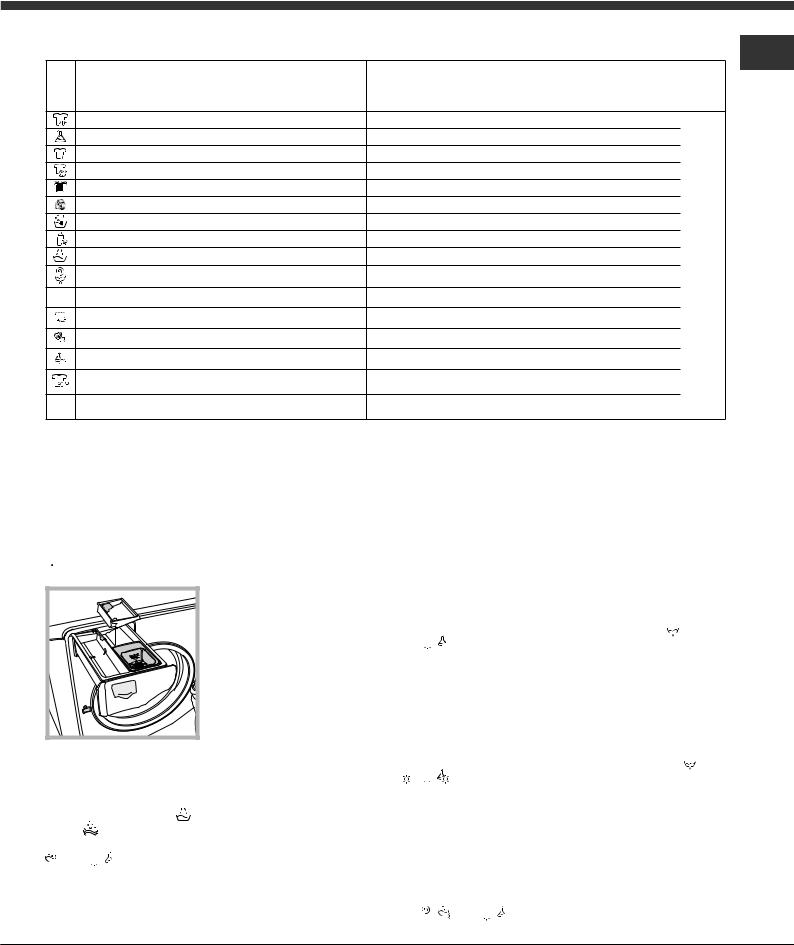
Wash cycles and options
Table of wash cycles |
EN |
|
Icon Description of the wash cycle
Cotton Coloureds (2): lightly soiled whites and delicate colours.
Synthetics Resistant
Whites
Coloureds
Darks
Wool Platinum Care: for wool, cashmere, etc.
Ultradelicates
Anti Allergy
Rinse
Spin and Pump out
 Wash&Dry
Wash&Dry
Drying Cottons
Drying Wool
Drying Synthetics
Cotton Hygiene Prewash
(Add detergent to the relevant compartment).
 Cotton Whites (1): heavily soiled whites and resistant colours.
Cotton Whites (1): heavily soiled whites and resistant colours.
Max. temp. |
Max. |
|
Detergent and additives |
Max. |
Cycle |
||||
speed |
Drying |
Pre- |
|
|
Fabric |
load |
|||
(°C) |
(rpm) |
|
wash |
Wash |
Bleach |
softener |
(kg) |
duration |
|
40° |
1600 |
|
- |
|
|
|
10 |
(*) |
|
The |
|||||||||
60° |
800 |
|
- |
|
|
|
5 |
||
60° |
1600 |
|
- |
|
- |
|
6 |
of duration |
|
40° |
1600 |
|
- |
|
|
|
6 |
||
30° |
800 |
|
- |
|
- |
|
6 |
||
40° |
800 |
|
- |
|
- |
|
2,5 |
the |
|
30° |
0 |
|
- |
|
- |
|
1 |
wash |
|
60° |
1600 |
|
- |
|
- |
|
6 |
||
cycles |
|||||||||
- |
1600 |
|
- |
- |
|
|
10 |
||
- |
1600 |
|
- |
- |
- |
- |
10 |
||
|
can |
||||||||
|
|
|
|
|
|
|
|
||
30° |
1600 |
|
- |
|
- |
|
1 |
be |
|
|
|
|
|
|
|
|
|
||
- |
- |
|
- |
- |
- |
- |
7 |
on checked |
|
- |
- |
|
- |
- |
- |
- |
2,5 |
||
- |
- |
|
- |
- |
- |
- |
5 |
||
the |
|||||||||
90° |
1600 |
|
|
|
- |
|
10 |
||
.display |
|||||||||
60° |
1600 |
|
- |
|
|
|
10 |
||
(Max. 90°C) |
|||||||||
|
|
|
|
|
|
|
|||
|
|
|
|
|
|
|
|
||
The length of cycle shown on the display or in this booklet is an estimation only and is calculated assuming standard working conditions. The actual duration can vary according to factors such as water temperature and pressure, the amount of detergent used, the amount and type of load inserted, load balancing and any wash options selected.
(*) Note: 10 minutes after the START, the machine will recalculate the time remaining until the end of the wash cycle on the basis of the load inside it; this value will then be shown on the display.
For all Test Institutes:
1)Test wash cycle in compliance with regulation EN 50229: set wash cycle  with a temperature of 60°C.
with a temperature of 60°C.
2)Long wash cycle for cottons: set wash cycle  with a temperature of 40°C.
with a temperature of 40°C.
Wash options
 Super Wash
Super Wash
This option offers a high-
 3 performance wash due to the greater quantity of water
3 performance wash due to the greater quantity of water
1used in the initial phase of the cycle, and due to
2 |
the increased wash cycle |
|
duration, is particularly useful |
||
|
||
|
for the removal of stubborn |
|
|
stains. It can be used with or |
|
|
without bleach. If you desire |
|
|
bleaching, insert the extra |
|
|
tray compartment (3) into |
|
compartment 1. When pouring in the bleach, be careful |
||
not to exceed the “max” level marked on the central pivot
(see figure). To bleach laundry without carrying out a full wash cycle, pour the bleach into the extra compartment 3,
select the “Rinse” cycle |
and activate the “Super Wash” |
option . |
|
! It cannot be used in conjunction with  ,
,  ,
,  ,
,  ,
,  ,
,  ,
,
,  ,
, 
 ,
,  ,
,  .
.
 Extra rinse
Extra rinse
By selecting this option, the efficiency of the rinse is increased and optimal residual detergent removal is guaranteed. It is particularly useful for skin which is
sensitive to detergents. We recommend this option is used with a full load of washing, or when a large amount of detergent is required.
! It cannot be used in conjunction with  ,
,  ,
,  ,
,  ,
,  ,
,
 ,
, 
 ,
,  .
.
 Easy Iron
Easy Iron
By selecting this option, the wash and spin cycles will be modified in order to reduce the formation of creases.
At the end of the cycle the Washer-dryer drum will rotate slowly; the “Easy Iron” and START/PAUSE indicator lights will flash. To end the cycle press the START/PAUSE button or the “Easy Iron” button.
! It cannot be used in conjunction with  ,
,  ,
,  ,
,  ,
,  ,
,  ,
,
 ,
, 
 , .
, .
Note: If you also want to run the drying cycle, this option is enabled only if combined with level “Iron”.
 Time Saver
Time Saver
If you select this option, the wash cycle duration will be reduced by up to 50%, depending on the selected cycle, thereby guaranteeing simultaneous water and energy saving. Use this cycle for lightly soiled garments.
! It cannot be used in conjunction with  ,
,  ,
,  ,
,  ,
,  ,
,
 ,
,  , ,
, ,  ,
, 
 ,
,  .
.
9

Detergents and laundry
EN Detergent
The type and quantity of detergent required depend on the type of fabric you are washing (cotton, wool, silk, etc.), as well as its colour, the washing temperature, the level of soiling and the hardness of the water in the area. Measuring out the detergent carefully will avoid wastage and help to protect the environment: although they are biodegradable, detergents still contain ingredients which alter the balance of nature.
We recommend the following:
•use powder detergents for white cotton garments and pre-washing.
•use liquid detergents for delicate cotton garments and for all low-temperature wash cycles.
•use gentle liquid detergents for wool and silk garments. The detergent should be poured into the relevant compartment - or the dispenser placed directly inside the drum - before the wash cycle begins. In the latter case, it will not be possible to select the Cottons with pre-wash cycle. ! Do not use hand washing detergents because these create too much foam.
Preparing the laundry
•Shake out the garments before loading them into the machine.
•Divide the laundry according fabric type (symbol on the washing instruction label) and colour, making sure you separate the coloured garments from the white ones;
•Empty all pockets and check the buttons;
•Do not exceed the values listed in the “Table of wash cycles”, which refer to the weight of the laundry when dry.
How much does your laundry weigh?
1 sheet |
400-500 g |
1 pillowcase |
150-200 g |
1 tablecloth |
400-500 g |
1 bathrobe |
900-1200 g |
1 towel |
150-250 g |
1 pair of jeans |
400-500 g |
1 shirt |
150-200 g |
Washing recommendations
Whites: use this cycle  to wash white clothes. The programme is designed to maintain the brightness of white clothes over time.
to wash white clothes. The programme is designed to maintain the brightness of white clothes over time.
If the drying function is selected, a drying cycle automatically activates at the end of the wash cycle that resembles open-air drying, with the added advantages of preserving garments from yellowing due to sunlight exposure and preventing loss of whiteness caused by the
possible presence of dust in the air. Drying cycles can only be selected on a level basis.
Coloureds: use this cycle  to wash bright coloured clothes. The programme is designed to maintain bright colours over time.
to wash bright coloured clothes. The programme is designed to maintain bright colours over time.
Darks: Use cycle  to wash dark-coloured garments. This programme is designed to maintain dark colours over time. We recommend using a liquid detergent for the best results when washing dark-coloured garments.
to wash dark-coloured garments. This programme is designed to maintain dark colours over time. We recommend using a liquid detergent for the best results when washing dark-coloured garments.
When you select the drying function, at the end of the washing cycle the machine will automatically perform a delicate drying cycle that preserves the colours of the
garments. The display will show the level “Hanger”. Max. load: 3 kg.
Wool: the wool wash cycle on this Hotpoint-Ariston machine has been tested and approved by The Woolmark Company for washing wool garments labelled as hand washable provided that the garments are washed according to the instructions on the garment label and those issued by the manufacturer of this Washer-dryer. Hotpoint-Ariston is the first Washer-dryer brand to be approved by The Woolmark Company for Apparel CarePlatinum for its washing performance and consumption of energy and water. (M1135) 


In UK, Eire, Hong Kong and India the Woolmark trade mark is a Certification trade mark.
Ultradelicates: use programme  to wash very delicate garments having strasses or sequins.
to wash very delicate garments having strasses or sequins.
We recommend turning the garments inside out before washing and placing small items into the special bag for washing delicates. Use liquid detergent on delicate garments for best results.
To wash Silk garments and Curtains select cycle  and then option
and then option  (in this case it will also be possible to enable the “Extra Rinse” option); the machine will end the cycle while the laundry is soaking and the
(in this case it will also be possible to enable the “Extra Rinse” option); the machine will end the cycle while the laundry is soaking and the  indicator light will flash. To drain the water so that the laundry may be removed, press the START/PAUSE button or the
indicator light will flash. To drain the water so that the laundry may be removed, press the START/PAUSE button or the  button.
button.
When selecting an exclusively time-based drying function, a drying cycle is performed at the end of the wash cycle that is particularly delicate, thanks to light handling and appropriate temperature control of the water jet.
The recommended durations are:
1 kg of synthetic garments --> 160 min
1 kg of synthetic and cotton garments --> 180 min 1 kg of cotton garments --> 180 min
The degree of dryness depends on the load and fabric composition.
Anti Allergy: use programme  to remove major allergens such as pollen, mites, cat’s and dog’s hair. Wash&Dry: select programme for washing and drying lightly soiled garments (Cotton and Synthetic) in a short time. This cycle may be used to wash and dry a laundry load of up to 1 kg in just 45 minutes. To achieve optimum results, use liquid detergent and pre-treat cuffs, collars and stains. Stubborn stains: it is wise to treat stubborn stains with solid soap before washing, and to use the Cottons with pre-wash cycle.
to remove major allergens such as pollen, mites, cat’s and dog’s hair. Wash&Dry: select programme for washing and drying lightly soiled garments (Cotton and Synthetic) in a short time. This cycle may be used to wash and dry a laundry load of up to 1 kg in just 45 minutes. To achieve optimum results, use liquid detergent and pre-treat cuffs, collars and stains. Stubborn stains: it is wise to treat stubborn stains with solid soap before washing, and to use the Cottons with pre-wash cycle.
Load balancing system
Before every spin cycle, to avoid excessive vibrations before every spin and to distribute the load in a uniform manner, the drum rotates continuously at a speed which is slightly greater than the washing rotation speed. If, after several attempts, the load is not balanced correctly, the machine spins at a reduced spin speed. If the load is excessively unbalanced, the Washer-dryer performs the distribution process instead of spinning. To encourage improved load distribution and balance, we recommend small and large garments are mixed in the load.
10

Trouble shooting
Your Washer-dryer could occasionally fail to work. Before contacting the Technical Assistance Centre (see “Assistance”), |
EN |
make sure that the problem cannot be solved easily using the following list. |
Problem:
The Washer-dryer does not switch on.
The wash cycle does not start.
The Washer-dryer does not fill with water.
The Washer-dryer door remains locked.
Possible causes / Solutions:
•The appliance is not plugged into the socket fully, or not enough to make contact.
•There is no power in the house.
•The door is not closed properly.
•The START/PAUSE button has not been pressed.
•The water tap has not been opened.
•A delayed start has been set.
•The water inlet hose is not connected to the tap.
•The hose is bent.
•The water tap has not been opened.
•There is no water supply in the house.
•The pressure is too low.
•The START/PAUSE button has not been pressed.
•If you have selected the  function, at the end of the cycle the Washer-dryer drum will rotate slowly; to end the cycle press the START/PAUSE button or the
function, at the end of the cycle the Washer-dryer drum will rotate slowly; to end the cycle press the START/PAUSE button or the  button.
button.
The machine continuously fills with |
• The drain hose is not fitted at a height between 65 and 100 cm from the floor |
water and drains. |
(see “Installation”). |
|
• The free end of the hose is under water (see “Installation”). |
|
• If the dwelling is on one of the upper floors of a building, there may be |
|
problems relating to water drainage, causing the Washer-dryer to fill with water |
|
and drain continuously. Special anti-draining valves are available in shops and |
|
help to prevent this inconvenience. |
|
• The wall drainage system is not fitted with a breather pipe. |
The Washer-dryer does not drain or |
• The wash cycle does not include draining: Some wash cycles require the drain |
spin. |
phase to be started manually (see “Wash cycles and options”). |
|
• The “Easy iron” option is enabled: to complete the wash cycle, press the |
|
START/PAUSE button (“Wash cycles and options”). |
|
• The drain hose is bent (see Installation). |
|
• The drainage duct is clogged. |
The machine vibrates a lot during the spin cycle.
•The drum was not unlocked correctly during installation (see “Installation”).
•The machine is not level (see “Installation” ).
•The machine is trapped between cabinets and walls (see “Installation”).
•The load is unbalanced (see “Detergents and laundry”).
The Washer-dryer leaks.
•The water inlet hose is not screwed on properly (see “Installation”).
•The detergent dispenser is blocked (to clean it, see “Care and maintenance”).
•The drain hose is not fixed in place properly (see “Installation”).
The icons corresponding to the “Phase in progress” flash rapidly at the same time as the ON/OFF indicator light.
There is too much foam.
•Switch off the machine and unplug it, wait for approximately 1 minute and then switch it back on again. If the problem persists, contact the Technical Assistance Service.
•The detergent is not suitable for machine washing (it should display the text “for Washer-dryer” or “hand and machine wash”, or the like).
•Too much detergent was used.
The Washer-dryer door remains • Perform the manual unlocking procedure (see “Precautions and tips”). locked.
The washer-dryer does not dry. • The appliance is not plugged into the socket, or not enough to make contact.
•There has been a power failure.
•The appliance door is not shut properly.
•A DELAY TIMER has been set.
•DRYING is in the OFF position.
11

Assistance
|
|
|
|
|
|
|
|
Before calling for Assistance: |
|
||||
EN |
|
|||||
• Check whether you can solve the problem by yourself (see “Trouble shooting”); |
|
|||||
|
|
|||||
|
• Restart the wash cycle to check whether the problem has been solved; |
|
||||
|
|
|||||
|
• If it has not, contact the Authorised Technical Assistance Service. |
|
||||
|
! If the Washer-dryer has been installed or used incorrectly, you will have to pay for the call-out service. |
|
||||
|
! Always request the assistance of authorised technicians. |
|
||||
Please have the following information to hand:
•the type of problem;
•the appliance model (Mod.);
•the serial number (S/N).
The above information can be found on the data plate located on the appliance itself.
! Note: to exit “Demo mode”, switch machine off, press and hold the two “START/PAUSE” 
 and “ON/OFF”
and “ON/OFF”  buttons simultaneously for 3 seconds.
buttons simultaneously for 3 seconds.
12

Istruzioni per l’installazione e l’uso
LAVASCIUGA
|
|
|
|
! |
Questo simbolo ti ricorda di leggere questo libretto istruzioni. |
|
|
I |
|||
|
|
||
|
|
|
I
Italiano
AQUALTIS
AQD1070D 69
Sommario
Installazione, 14-15
Disimballo e livellamento
Collegamenti idraulici ed elettrici
Dati tecnici
Manutenzione e cura, 16
Escludere acqua e corrente elettrica Pulire la macchina
Pulire il cassetto dei detersivi Curare il cestello
Pulire la pompa
Controllare il tubo di alimentazione dell’acqua
Precauzioni e consigli, 17
Sicurezza generale
Smaltimento
Apertura manuale della porta oblò
Descrizione della macchina, 18-19
Pannello comandi touch control
Come effettuare un ciclo di lavaggio o asciugatura, 20
Programmi e opzioni, 21
Tabella Programmi
Le opzioni di lavaggio
Detersivi e biancheria, 22
Detersivo
Preparare la biancheria
Consigli di lavaggio
Sistema bilanciamento del carico
Anomalie e rimedi, 23
Assistenza, 24
Assistenza Attiva 7 giorni su 7
13
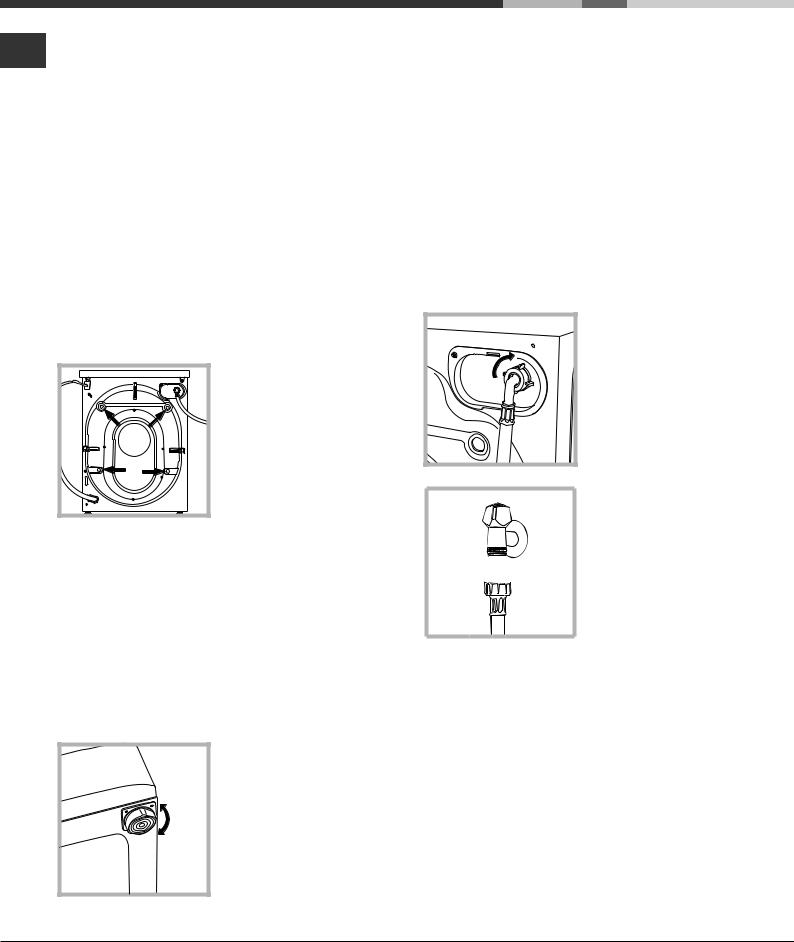
Installazione
!E’ importante conservare questo libretto per I poterlo consultare in ogni momento. In caso di vendita, di cessione o di trasloco, assicurarsi
che resti insieme alla lavasciuga.
!Leggere attentamente le istruzioni: ci sono importanti informazioni sull’installazione, sull’uso e sulla sicurezza.
!Nella busta contenente questo libretto troverete, oltre alla garanzia, dei particolari che serviranno per l’installazione.
Disimballo e livellamento
Disimballo
1. Una volta disimballata la lavasciuga, controllare che non abbia subito danni durante il trasporto.
Se fosse danneggiata non collegarla e contattare il rivenditore.
2. Rimuovere le 4 viti di protezione per il trasporto ed il relativo distanziale posti nella parte posteriore (vedi figura).
3.Chiudere i fori con i tappi di plastica contenuti nella busta.
4.Conservare tutti i pezzi; qualora la lavasciuga dovesse essere trasportata, dovranno essere rimontati per evitare danneggiamenti interni.
! Gli imballaggi non sono giocattoli per bambini.
Livellamento
1. Posizionare la lavasciuga su un pavimento piano e rigido, senza appoggiarla a muri o mobili.
2. Compensare le irregolarità svitando o avvitando i piedini
finchè la macchina non sia orizzontale (non deve essere inclinata più di 2 gradi).
!Un accurato livellamento dà stabilità ed evita vibrazioni e rumorosità soprattutto nella fase di centrifuga.
!In caso sia posizionata su moquette
o tappeti, regolare i piedini in modo da conservare sotto la lavasciuga lo spazio necessario per la ventilazione.
Collegamenti idraulici ed elettrici
Collegamento del tubo di alimentazione dell’acqua
! Prima di collegare il tubo di alimentazione alla rete idrica, far scorrere l’acqua finché non sia limpida.
1. Collegare il tubo di alimentazione alla macchina avvitandolo all’apposita presa d’acqua, nella parte posteriore in alto a destra (vedi figura).
2. Collegare il tubo di alimentazione avvitandolo a un rubinetto d’acqua fredda con bocca filettata da 3/4 gas
(vedi figura).
3. Fare attenzione che nel tubo non ci siano né pieghe né strozzature.
!La pressione idrica del rubinetto deve essere compresa nei valori della tabella Dati tecnici (vedi pagina a fianco).
!Se la lunghezza del tubo di alimentazione non fosse sufficiente, rivolgersi a un negozio specializzato o a un tecnico autorizzato.
!Non utilizzare mai tubi di carico usati o vecchi, ma quelli in dotazione alla macchina.
14
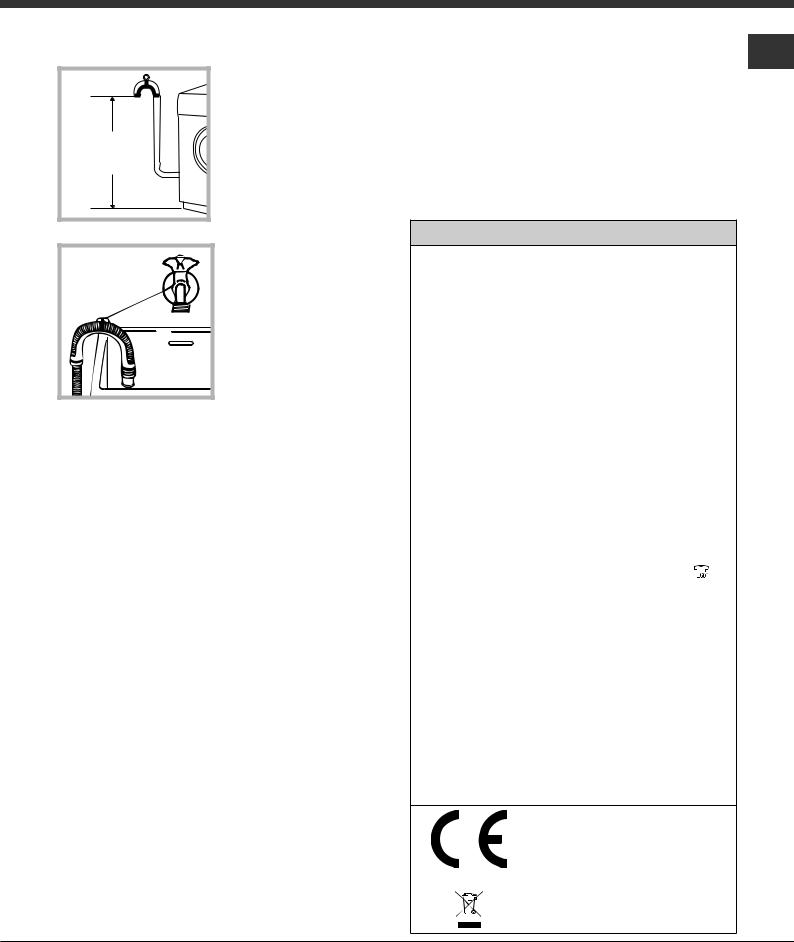
Collegamento del tubo di scarico
65 - 100 cm |
Collegare il tubo di scarico a una conduttura di scarico o a uno
scarico a muro posti tra 65 e 100 cm da terra evitando assolutamente di piegarlo.
In alternativa,
appoggiare il tubo
di scarico al bordo di un lavandino o di una vasca, legando
la guida in dotazione
al rubinetto (vedi
figura).
L’estremità libera
del tubo di scarico non deve rimanere
immersa nell’acqua.
! È sconsigliato usare tubi di prolunga; se indispensabile, la prolunga deve avere lo stesso diametro del tubo originale e non superare i 150 cm.
Collegamento elettrico
Prima di inserire la spina nella presa della corrente, accertarsi che:
•la presa abbia la messa a terra e sia a norma di legge;
•la presa sia in grado di sopportare il carico massimo di potenza della macchina,
indicato nella tabella Dati tecnici (vedi a fianco);
•la tensione di alimentazione sia compresa nei valori indicati nella tabella Dati tecnici (vedi a fianco);
•la presa sia compatibile con la spina della macchina. In caso contrario far sostituire la
presa o la spina.
!La macchina non va installata all’aperto, nemmeno se lo spazio è riparato, perché è molto pericoloso lasciarla esposta a pioggia e temporali.
!A macchina installata, la presa della corrente deve essere facilmente raggiungibile.
! Non usare prolunghe e multiple. |
I |
|
!Il cavo non deve subire piegature o compressioni.
!Il cavo di alimentazione e la spina devono essere sostituiti solo da tecnici autorizzati.
Attenzione! L’azienda declina ogni responsabilità qualora queste norme non vengano rispettate.
Dati tecnici
Modello |
AQD1070D 69 |
|
|
|
|
|
larghezza cm 59,5 |
|
Dimensioni |
altezza cm 85 |
|
|
profondità cm 64,5 |
|
Capacità |
da 1 a 10 kg per il lavaggio |
|
da 1 a 7 kg per l’asciugatura |
||
|
||
Collegamenti |
vedi la targhetta caratteristi- |
|
che tecniche applicata sulla |
||
elettrici |
macchina |
|
|
||
|
pressione massima 1 MPa |
|
Collegamenti |
(10 bar) |
|
pressione minima 0,05 MPa |
||
idrici |
(0,5 bar) |
|
|
capacità del cesto 71 litri |
|
Velocità di |
sino a 1600 giri al minuto |
|
centrifuga |
||
|
||
|
lavaggio: programma ; |
|
|
temperatura 60°C; effettuato |
|
|
con 10 kg di carico. |
|
|
asciugatura: l’asciugatura |
|
|
del carico minore deve es- |
|
Programmi |
sere effettuata selezionando |
|
di prova |
il livello di asciugatura |
|
secondo la |
“EXTRA”, il carico di bian- |
|
direttiva |
cheria deve essere compo- |
|
EN 50229 |
sto da 3 lenzuola, 2 federe e |
|
|
1 asciugamano; |
|
|
l’asciugatura del carico |
|
|
restante deve essere effet- |
|
|
tuata selezionando il livello di |
|
|
asciugatura “EXTRA”. |
Questa apparecchiatura è conforme alle seguenti Direttive Comunitarie:
-2004/108/CE (Compatibilità Elettromagnetica)
-2002/96/CE
- 2006/95/CE (Bassa Tensione)
15
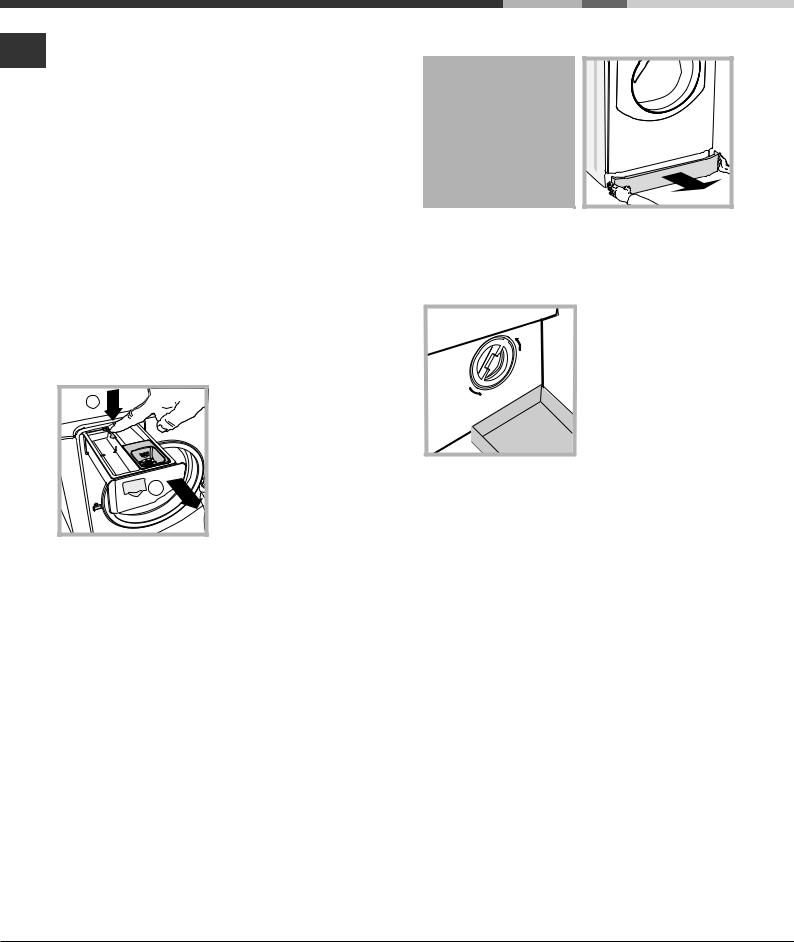
Manutenzione e cura
IEscludereelettrica acqua e corrente
•Chiudere il rubinetto dell’acqua dopo ogni lavaggio. Si limita così l’usura dell’impianto idraulico della macchina e si elimina il pericolo di perdite.
•Staccare la spina della corrente quando si pulisce la macchina e durante i lavori di manutenzione.
Pulire la macchina
La parte esterna e le parti in gomma possono essere puliti con un panno imbevuto di acqua tiepida e sapone. Non usare solventi o abrasivi.
Pulire il cassetto dei detersivi
1 |
1 |
2 |
2 |
Per estrarre il cassetto premere la leva (1) e tirarlo verso l’esterno (2)
(vedi figura).
Lavarlo sotto l’acqua corrente; questa pulizia va effettuata frequentemente.
Curare il cestello
•Lasciare sempre socchiusa la porta oblò per evitare che si formino cattivi odori.
Pulire la pompa
La macchina è dotata di una pompa autopulente che non ha bisogno di manutenzione. Può però succedere che piccoli oggetti (monete, bottoni) cadano nella precamera che protegge la pompa, situata nella parte inferiore di essa.
! Assicurarsi che il ciclo di lavaggio sia terminato e staccare la spina.
Per accedere alla precamera:
1. rimuovere il pannello di copertura sul lato anteriore della macchina premendo verso il centro, quindi spingere verso il basso da entrambe i lati ed estrarlo (vedi figure);
2. posizionare un contenitore per raccogliere l’acqua che uscirà (circa 1,5 lt) (vedi figura);
3. svitare il coperchio ruotandolo in senso antiorario (vedi figura);
4.pulire accuratamente l’interno;
5.riavvitare il coperchio;
6.rimontare il pannello assicurandosi, prima di spingerlo verso la macchina, di aver inserito i ganci nelle apposite asole.
Controllare il tubo di alimentazione dell’acqua
Controllare il tubo di alimentazione almeno una volta all’anno. Se presenta screpolature e fessure va sostituito: durante i lavaggi le forti pressioni potrebbero provocare improvvise spaccature.
16
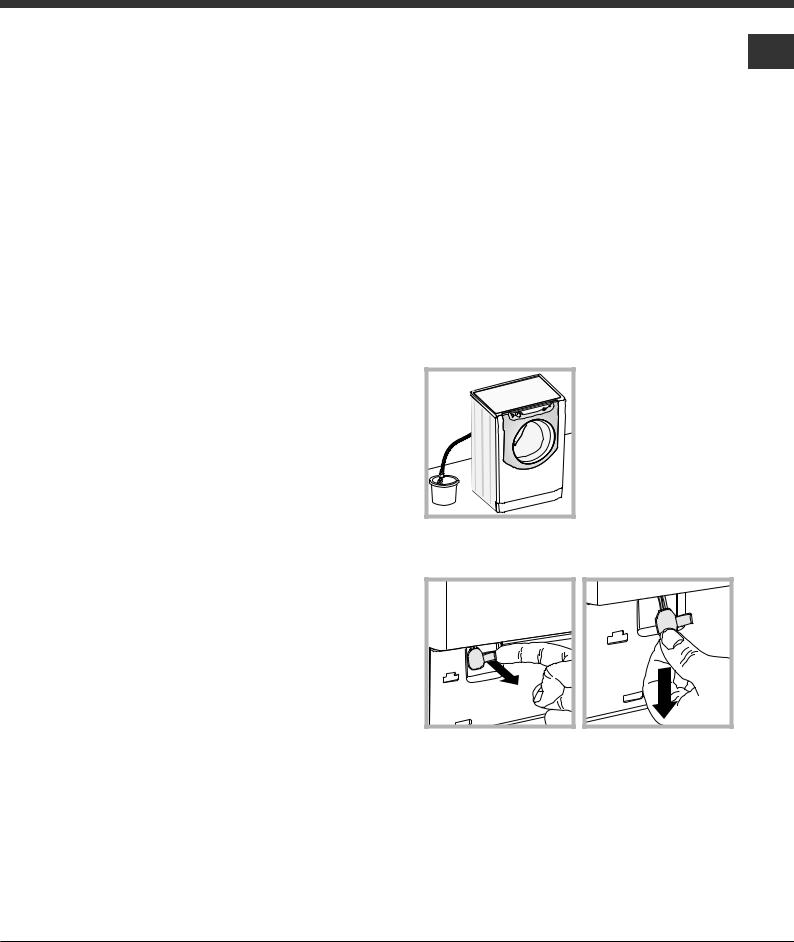
Precauzioni e consigli
! La macchina è stata progettata e costruita in conformità alle norme internazionali di sicurezza. Queste avvertenze sono fornite per ragioni di
sicurezza e devono essere lette attentamente.
Sicurezza generale
•Questo apparecchio è stato concepito esclusivamente per un uso di tipo domestico.
•L’apparecchio non deve essere utilizzato da persone (bambini compresi) con capacità fisiche, sensoriali o mentali ridotte e con esperienze e conoscenze
insufficienti, a meno che tale utilizzo non avvenga sotto la supervisione o le istruzioni di una persona responsabile della loro sicurezza.
I bambini devono essere sorvegliati per garantire che non giochino con l’apparecchio.
-Non asciugare capi non lavati.
-I capi sporchi di sostanze quali l’olio di cottura, l’acetone, l’alcol, la benzina, il cherosene, gli smacchiatori, la trementina, la cera e le sostanze per rimuoverla devono essere lavati in acqua calda con una quantità maggiore di detergente prima di asciugarli nell’asciugabiancheria.
-Oggetti come la gomma espansa (schiuma di lattice), le cuffie per la doccia, i materiali tessili impermeabili, gli articoli con un lato di gomma e i vestiti o i cuscini che hanno delle parti in schiuma di lattice non devono essere asciugati nell’asciugabiancheria.
-Ammorbidenti o prodotti simili devono essere usati conformemente alle istruzioni del produttore.
-La parte finale di un ciclo dell’asciugabiancheria avviene senza calore (ciclo di raffreddamento) per garantire che gli articoli non vengano danneggiati.
ATTENZIONE: Non arrestare mai un’asciugabiancheria prima del termine del programma di asciugatura.
In questo caso prelevare rapidamente tutti i capi di biancheria e stenderli per farli raffreddare rapidamente.
•Non toccare la macchina a piedi nudi o con le mani o i piedi bagnati o umidi.
•Non staccare la spina dalla presa della corrente tirando il cavo, bensì afferrando la spina.
•Non toccare l’acqua di scarico, che può raggiungere temperature elevate.
•Non forzare in nessun caso la porta l’oblò: potrebbe
danneggiarsi il meccanismo di sicurezza che protegge da aperture accidentali.
•In caso di guasto, in nessun caso accedere ai meccanismi interni per tentare una riparazione.
•Controllare sempre che i bambini non si avvicinino alla macchina in funzione.
•Se deve essere spostata, lavorare in due o tre persone con la massima attenzione. Mai da soli perché la macchina è molto pesante.
•Prima di introdurre la biancheria controllare che il cestello sia vuoto.
•Durante l’asciugatura l’oblò tende a scaldarsi.
•Non asciugare biancheria lavata con solventi infiammabili (es. trielina).
•Non asciugare gommapiuma o elastomeri analoghi.
•Assicurati che durante le fasi di asciugatura il rubinetto dell’acqua sia aperto.
Smaltimento |
I |
|
• Smaltimento del materiale di imballaggio: attenersi |
||
|
||
alle norme locali, così gli imballaggi potranno essere |
|
|
riutilizzati. |
|
|
• La direttiva Europea 2002/96/CE sui rifiuti di |
|
|
apparecchiature elettriche ed elettroniche, prevede che |
|
|
gli elettrodomestici non debbano essere smaltiti nel |
|
|
normale flusso dei rifiuti solidi urbani. Gli apparecchi |
|
|
dismessi devono essere raccolti separatamente |
|
|
per ottimizzare il tasso di recupero e riciclaggio dei |
|
|
materiali che li compongono ed impedire potenziali |
|
|
danni per la salute e l’ambiente. Il simbolo del cestino |
|
|
barrato è riportato su tutti i prodotti per ricordare gli |
|
|
obblighi di raccolta separata. |
|
|
Per ulteriori informazioni, sulla corretta dismissione |
|
|
degli elettrodomestici, i detentori potranno rivolgersi al |
|
|
servizio pubblico preposto o ai rivenditori. |
|
|
Apertura manuale della porta oblò |
|
|
In mancanza di energia elettrica è possibile aprire la porta |
|
|
per scaricare il bucato procedendo nel modo seguente: |
|
|
1. togliere la spina dalla |
|
|
presa di corrente. |
|
|
2. verificate che il livello |
|
|
dell’acqua all’interno della |
|
|
macchina sia inferiore |
|
|
rispetto all’apertura dell’oblò; |
|
|
in caso contrario togliere |
|
|
l’acqua in eccedenza |
|
|
attraverso il tubo di scarico |
|
|
raccogliendola in un secchio |
|
|
come indicato in figura. |
|
|
3. rimuovere il pannello di copertura sul lato anteriore |
|
|
della lavabiancheria (vedi pagina seguente). |
|
4.utilizzando la linguetta indicata in figura tirare verso l’esterno fino a liberare il tirante in plastica dal fermo; tirarlo successivamente verso il basso fino a sentire un “click” che indica che la porta è sbloccata.
5.aprite la porta; nel caso non sia ancora possibile ripetete l’operazione.
6.rimontare il pannello assicurandosi, prima di spingerlo verso la macchina, di aver inserito i ganci nelle apposite asole.
17
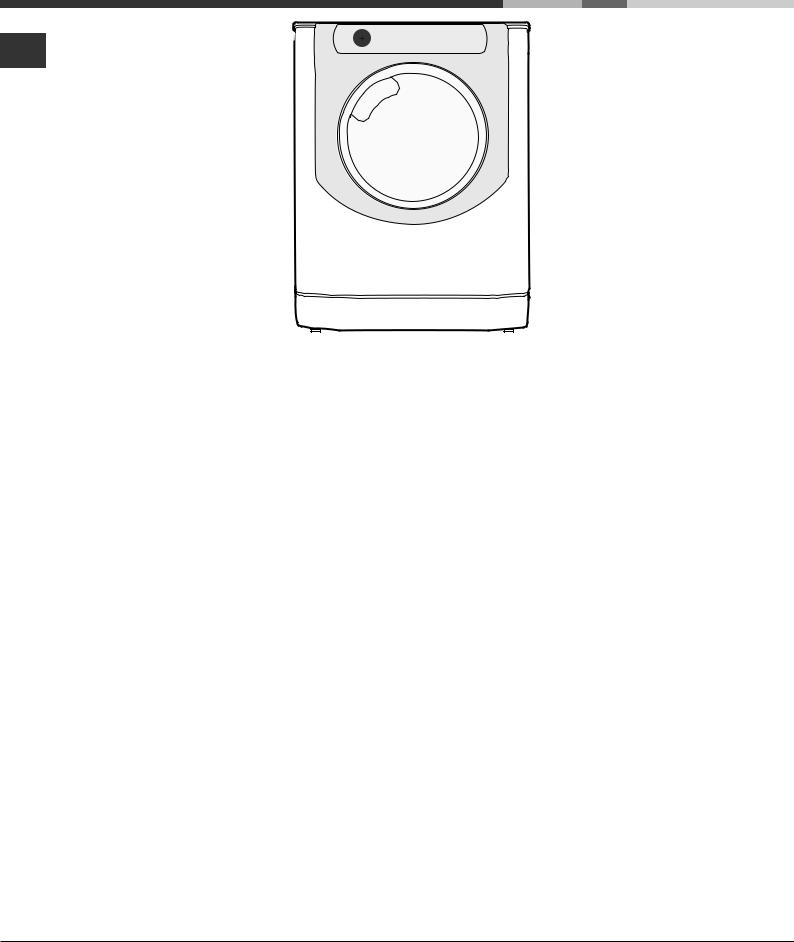
Descrizione della macchina
|
|
PANNELLO |
|
I |
|
COMANDI TOUCH |
|
PORTA OBLÒ |
CONTROL |
||
|
|||
|
|
||
|
MANIGLIA |
|
|
|
PORTA OBLÒ |
|
ZOCCOLO
PIEDINI REGOLABILI
PORTA OBLO’
Per aprire la porta oblò utilizzare sempre l’apposita maniglia (vedi figura).
CASSETTO DEI DETERSIVI
Si trova all’interno della mac-
china e vi si accede aprendo la
porta. Per il dosaggio dei detersivi vedi il capitolo “Detersivi e biancheria”.
Per l’utilizzo del detersivo in polvere riporre la paretina nella cavità B.
3. vaschetta aggiuntiva: Candeggina
! L’utilizzo della vaschetta aggiuntiva 3 esclude il prelavaggio.
 vaschetta per additivi: per ammorbidente o additivi liquidi. Si raccomanda di non superare mai il livello massimo indicato dalla griglia e di diluire ammorbidenti concentrati.
vaschetta per additivi: per ammorbidente o additivi liquidi. Si raccomanda di non superare mai il livello massimo indicato dalla griglia e di diluire ammorbidenti concentrati.
PANNELLO COMANDI TOUCH CONTROL
Per modificare le
impostazioni premere
leggermente sull’icona all’interno dell’area sensibile (touch control) come indicato nella figura.
|
A |
3 |
|
|
|
|
|
1 |
B |
|
2 |
1.vaschetta per il prelavaggio: usare detersivo in polvere.
! Prima di versare il detersivo verificare che non sia inserita la vaschetta aggiuntiva 3.
2.vaschetta per il lavaggio: Nel caso di utilizzo di detersivo liquido si consiglia di utilizzare la paretina A in dotazione per un corretto dosaggio.
Modalità di stand by
Questa lavatrice, in conformità alle nuove normative legate al risparmio energetico, è dotata di un sistema di autospegnimento (stand by) che entra in funzione dopo circa 30 minuti nel caso di non utilizzo. Premere
brevemente il tasto ON/OFF e attendere che la macchina si riattivi.
Consumo in off-mode: 0,5 W Consumo in Left-on: 0,5 W
18
